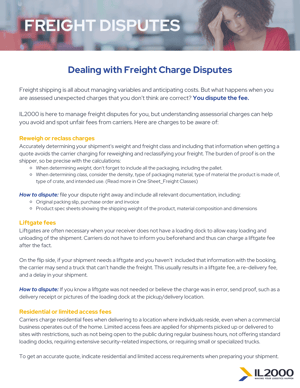Shipping goods from point A to point B is critical for managing supply chains, meeting market demands and, yes, even detecting incoming bombers during the Cold War (more on that later). Balancing costs against speed, reliability and distance can be challenging. But being charged fees after delivery is frustrating, and may result in paying more than you should.
We’ll show you how to avoid unexpected fees and arm you to dispute unfair charges.
But first, a foray into the frozen North…
Distant Early Warning Line – a triumph of logistics by air, land and water
_Line.jpg?width=400&name=Map_of_Distant_Early_Warning_(DEW)_Line.jpg) During the Cold War, early warning of incoming Soviet bombers or any sea-and-land invasions was deemed critical. So, the Canadian and United States governments hatched a plan to construct a system of radar stations running through the northern Arctic region spanning Alaska, Canada, Greenland and Iceland. The DEW (Distant Early Warning Line) was the northernmost and most capable of three radar lines in Canada and Alaska.
During the Cold War, early warning of incoming Soviet bombers or any sea-and-land invasions was deemed critical. So, the Canadian and United States governments hatched a plan to construct a system of radar stations running through the northern Arctic region spanning Alaska, Canada, Greenland and Iceland. The DEW (Distant Early Warning Line) was the northernmost and most capable of three radar lines in Canada and Alaska.
Advance site preparation began in December 1954. It took three years, 25,000 people and 460,000 tons of materials to build the 63-base line across the remote and frozen land. To put the volume of materials in perspective, the gravel used for construction was enough to build two Great Pyramids at Giza.
“In transportation and construction effort, building the DEW Line was roughly equivalent to the job of taking 2,000 Statues of Liberty dismantled into reasonable sized units, moving them from New York Harbor to dozens of spots inside the Arctic Circle, and putting them together again in darkness, blizzards and sub-zero cold,” wrote the Western Electric Corporation, the company responsible for managing the design and construction of the line.
The teams had to get creative with arranging the shipments. Nothing was simple with these land, air and sea modes. The logistics took place mainly in the summer months when the remote sites could be reached by sea using sealifts and barges. Aircraft of every kind, from bush planes and light planes fitted with skis to four-engined turboprops made drops while off-road overland trains with a payload capacity of 150 short tons crossed the massive distances. Even 'snowmobiles' and dog sleds were used in temperatures too low for thermometers to measure.
Throughout this logistics feat, military and naval units were indispensable; men were given special training for unloading ships in the Arctic and raced against time during the few weeks the ice was open to land supplies. They solved problems and kept freight moving, much as 3PLs do today.
 For nearly 30 years, the DEW Line provided a vital first line of defense until it was modernized and merged with newly built stations to create the North Warning System in 1985. In 1993, after the collapse of the Soviet Union and the end of the Cold War, the DEW Line stations were dismantled. The massive clean-up project was finally completed in 2014.
For nearly 30 years, the DEW Line provided a vital first line of defense until it was modernized and merged with newly built stations to create the North Warning System in 1985. In 1993, after the collapse of the Soviet Union and the end of the Cold War, the DEW Line stations were dismantled. The massive clean-up project was finally completed in 2014.
Now back to today and dealing with freight disputes
Today's shipments don’t even come close to the complexity of a cat train with crawler tractors pulling sleds of materials, a bunkhouse, a kitchen, fuel and spare parts across the Arctic. (I bet that qualifies for extra delivery charges!) But understanding charges can be complex.
Below is a list of frequent carrier fees that crop up unexpectedly and tips on how to dispute the charges.
- Reweigh or reclass charges: Accurately determining your shipment's weight and freight class and including that information when getting a quote avoids the carrier charging for reweighing and reclassifying your freight. The burden of proof is on the shipper, so be precise with the calculations:
- When determining weight, don’t forget to include all the packaging, including the pallet.
- When determining class, consider the density, type of packaging material, type of material the product is made of, type of crate, and intended use. (Read more in One Sheet_Freight Classes)
How to dispute: file your dispute right away and include all relevant documentation, including:- Original packing slip, purchase order and invoice
- Product spec sheets showing the shipping weight of the product, material composition and dimensions
- Liftgate fees: Liftgates are often necessary when your receiver does not have a loading dock to allow easy loading and unloading of the shipment. Carriers do not have to inform you beforehand and thus can charge a liftgate fee after the fact.
On the flip side, if your shipment needs a liftgate and you haven’t included that information with the booking, the carrier may send a truck that can’t handle the freight. This usually results in a liftgate fee, a re-delivery fee, and a delay in your shipment.
How to dispute: If you know a liftgate was not needed or believe the charge was in error, send proof, such as a delivery receipt or pictures of the loading dock at the pickup/delivery location. - Residential or limited access fees: Carriers charge residential fees when delivering to a location where individuals reside, even when a commercial business operates out of the home. Limited access fees are applied for shipments picked up or delivered to sites with restrictions, such as not being open to the public during regular business hours, not offering standard loading docks, requiring extensive security-related inspections, or requiring small or specialized trucks.
To get an accurate quote, indicate residential and limited access requirements when preparing your shipment.
How to dispute: If the carrier has considered a destination residential because the consignee is an individual rather than a company, you can dispute the charges by providing documentation or photos of the facility, roads and loading docks. - Inside delivery area charges: Charges are imposed when drivers must deliver freight further than the "norm." This includes up a driveway, around a corner, and into a garage. The further the freight needs to be delivered (more than a few feet into a building, up stairs or into an elevator), the higher the charge.
To get an accurate quote, indicate inside delivery when preparing your shipment.
How to dispute: If the driver performed this service, this charge cannot be disputed. The carrier is not required to provide notification or get permission for inside delivery. To avoid unexpected charges, ensure you indicate if the shipment needs inside delivery on the quote. - Re-delivery fees: Carriers apply a fee when delivery is attempted (during regular business hours) but not fulfilled, necessitating an additional trip to deliver the shipment. Possible issues include delivery to businesses in downtown areas with ordinances restricting large trucks, parking lots too small for a tractor/trailer, and strip malls with inadequate space for the tractor/trailer to enter or exit.
How to dispute: You can dispute these charges if the carrier was at fault (going to the wrong address or trying to deliver outside of working hours). To dispute a re-delivery charge, you will need to provide:- Bill of lading
- Delivery receipt
- Statement from the receiver
- Poof of regular business hours
- Appointment / notification fees: If a consignee requires a delivery appointment or notification prior to delivery, the shipper must request this service, and charges will apply. If you do not include this information and the consignee requires this service, the carrier will bill you and is not obligated to notify you or get permission beforehand.
Familiarize yourself with the special requirements of the consignee and the limitations associated with the destination location to help avoid surprise charges.
How to dispute: If you know that an appointment or notification was not needed, you can do the following to prove that service was never requested:- Check the bill of lading
- Speak with the receiver to determine validity
- Check the delivery report
- Over-length fees: Carriers charge long and narrow shipments an overlength fee because they take up an extra-long space (but not width), leaving dead space in the transport vehicle. Most fees are per piece, but if the carrier allows, you can bundle packaging to reduce cost.
The easiest way to avoid an over-length fee is to provide precise dimensions on the initial quote. No estimates!
If a carrier re-measures your shipment and finds it larger than you quoted, they may charge a freight inspection fee on top of the over-length fee.
How to dispute: If your shipment did not meet the requirements for an over-length fee and you feel you were incorrectly charged, you can file a dispute using the following:- Original packing slip, purchase order and invoice
- Product spec sheets showing the shipping weight of the product, material composition and dimensions
- Guaranteed delivery fees: With guaranteed delivery service, carriers deliver by the date on the bill of lading, sometimes expediting the shipment to ensure they make the deadline. If the delivery date on your bill of lading requires faster service than standard transit allows, they may take this as a request for expedited service, and the charge is valid.
How to dispute: You must report guaranteed service failures to the carrier within 15 (calendar) days. If you requested guaranteed service but the delivery did not arrive on time, you can have the guarantee fee removed by providing documentation that:- A guarantee was requested
- All the carrier’s requirements for guaranteed shipments were followed
- There were no delays beyond the carrier’s control (such as severe weather, border closures, or strikes)
It doesn’t take 25,000 people, only one 3PL
You’re probably not battling sub-zero temperatures and tired Huskies to run your shipping operation, but keeping your charges in check can still feel like a precision military operation.
We encourage you to understand assessorial charges so you can avoid and spot unfair fees from carriers. But if you’d rather not have to deal with disputes yourself, IL2000 has a team of experts at your disposal.
Get in touch to see how we can make your logistics happen.
Download One Sheet: Freight Disputes


